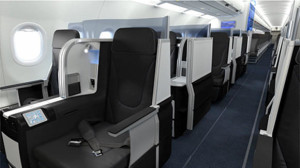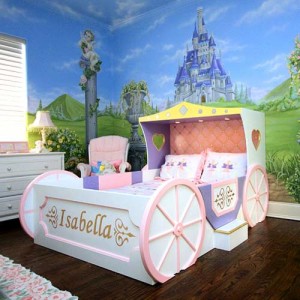 Steve Sipress
Head Rhino & Chief Strategist
Steve Sipress
Head Rhino & Chief Strategist
JetBlue Wakes Up – How About You?

Discount airline JetBlue has finally realized how much money they’ve been leaving on the table.
You’re familiar with their overall business strategy, right?
Despite having low fares, their passengers have enjoyed leather seats, spacious legroom, award-winning customer service, no hidden fees, free and unlimited snacks, satellite radio, personal TV screens at every seat and–starting back in early 2008–free in-flight Wi-Fi access.
This low-cost + high-quality approach served them well for their first few years in business – but when growth slowed and profits disappeared, they started charging for some of these previously-free amenities.
Then on Monday, they announced that they’re going to start outfitting some of their planes with high-priced, lie-flat first-class seats, complete with massage and larger television screens.
Finally.
As The Wall Street Journal puts it, “The new seats are an admission that JetBlue has been missing out on the most profitable part of the market—premium seats.”
Such fear of raising prices is extremely common among business owners.
In fact, I’ve found that in my experience helping thousands of business owners, raising prices or charging what they’re worth is one of toughest things for them to bring themselves to do (until they actually do it, at which point all I ever hear is “Thanks, Steve! I wish I had done this a long time ago!”).
Poor pricing strategy is one of the major causes of frustration, lack of profits and even the total demise of many businesses.
Everyone learns and grows at his or her own pace, so some business owners understand this concept quickly while others take much longer to get it. And sadly, some never get it at all.
Just the other day, when I questioned why one of my clients insists on charging an absurdly low fee for one of his services, he defended his self-destructive pricing strategy by starting to lecture me all about “industry norms.”
Yuck! Of course I had to stop him as soon as he started heading down that dead-end road to misery.
Think about it…
Since when is “conforming to the norm” a goal for a business owner, entrepreneur or sales professional – or a recipe for success in a crowded, competitive marketplace?
In reality, of course, the complete opposite is true:
The key to standing out and becoming successful is to be unique.
Throughout my 35-year career as a business owner and sales professional, I have personally always gone out of my way to sell the highest-priced products and services in whatever industry I’ve worked, and I’ve helped many others to recognize the tremendous power (and profitability) in this marketplace position.
I always want to have to answer the prospect’s question, “Oh yeah? Why is yours so expensive?” instead of screaming “Mine is merely the same or lower-quality than all the others” or “I don’t believe there’s anything special about what I sell” by charging “the industry norm” or trying to compete on price.
After all, in our society there is a very strong perceived link between price and quality.
For example…
- Would you rather wear a $3,000 suit or dress, or a $200 one?
- If a judge gave you a choice of who would be appointed to represent you, would you rather have the $1,000-an-hour lawyer or the $150-an-hour one?
- If someone tried to sell you a brand-new Mercedes for $5,000, you’d think it was stolen, and/or had no engine, and/or wasn’t really brand-new. You would immediately ask yourself, and the salesperson, “What’s wrong with it?”
(I remember having this feeling as a teenager when I got accepted into a college I thought I wanted to attend because of their celebrated school of broadcasting. About a week later, I received a letter from them inviting me to apply for their “Honors Program.” I immediately thought, “How desperate are they to attract any decent students? This must not be a great school overall, so it’s probably not too smart for me to go there,” and I crossed them right off my list.)
You know that people can’t help but make an instant snap judgment about the quality (or lack thereof) of any product or service simply based on its price. So don’t you want people to think in regard to your product or service, “Wow. With a price that high, it must be great!”
Let me give you some real-life examples…
- What’s the most ridiculously-high price you think you could charge for a little girl’s bed? ABaby.com gets $8,999 for their “Enchanting Princess Carriage Bed.”
- How about men’s underwear? A single pair at RevolutionWear.com will set you back a cool hundred bucks.
- At LaPetiteMaison.com, you can buy their 14 x 16 foot children’s “Tudor” playhouse for $75,000
- or their “Mediterranean” doghouse (modeled after model Rachel Hunter’s California home) for a mere $30,000.
- And for car buffs, how about a single bottle of wax for $97,000?




I’m not saying you have to go to these kind of extremes; I’m just showing you how ANY product or service, no matter how much of a “commodity” you think it is, can be made to be a luxury-priced offering.
Still not convinced?
Then read on…
Have you ever heard the saying “air is free”? So why do people gladly pump fistfuls of quarters into air machines to fill their cars’ tires at gas stations across the country? And why are there “oxygen bars” that charge about a dollar a minute for the privilege of inhaling the stuff?
And as if that isn’t outrageous enough…
How about the idea of selling Coke without the Coke – but charging the same price for a bottle? That’s right, I’m talking about Dasani water.
If you tried to convince me when I was a kid that someday Americans would be happily paying millions of dollars for air and water, I would have thought you were completely insane – and may even have tried to tell you about “industry norms” and other such nonsense.
(*By the way, in case you think there’s any real difference in taste or quality between different bottled waters, you might change your mind after you watch this brilliant Penn & Teller video. WARNING: Adult language.)
If by now you’re convinced of the benefit of raising your own prices, you might still be thinking, “Sure, Steve. But I can’t just raise my prices for no reason.”
Congratulations. At least you’ve come to the all-important conclusion that raising your prices is the smart thing to do.
Now you’re ready to pay attention to a crucial concept that I teach…
“If you want to double your price, triple your value.”
That’s what the makers of these playhouses, underwear and air machines did; they increased the quality of materials and construction and/or convenience of their deliverable – in other words, they increased the perceived value of what they sell.
You might also want to find ways to improve the quality of your services.
Or maybe you already provide better quality products or services than your competition, but up until now you’ve thought you still had to compete on price, or were afraid to pull the trigger and start to charge what you’re worth.
Don’t worry. That’s extremely common – and easily overcome.
Here’s how…
If you’re not 100% sure of making this change, then at least get started by testing out a higher price on just one product or service you sell – or add a premium or “VIP” level of service for your prospects and customers who want it.
That’s what JetBlue just announced it’s about to do. And that just might make all the difference between either profitability or continued struggles for their company.
So. How about you?
With all my heart, I sincerely hope you go for it!

4 Responses to JetBlue Wakes Up – How About You?